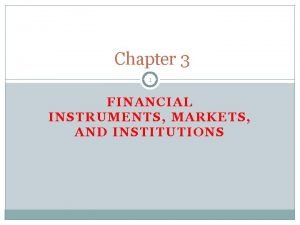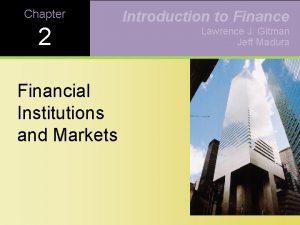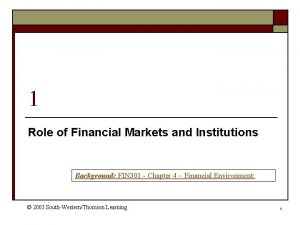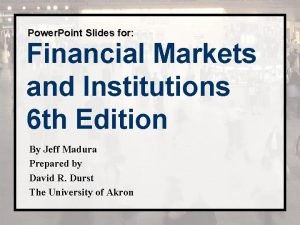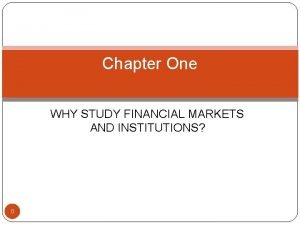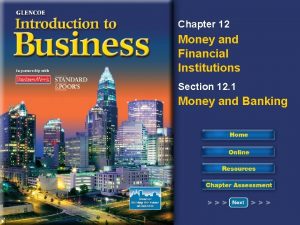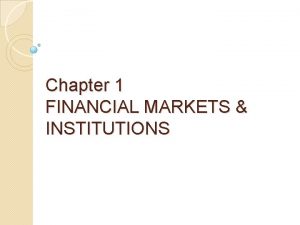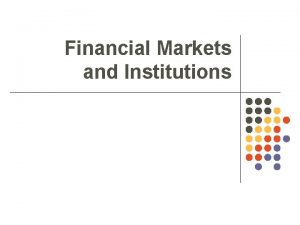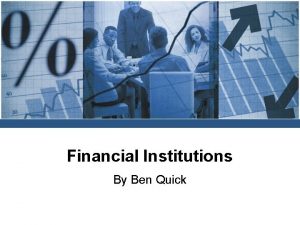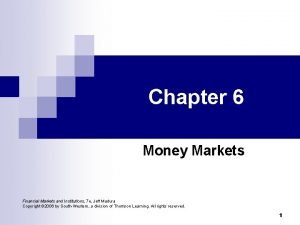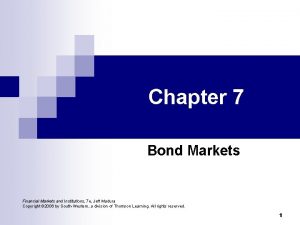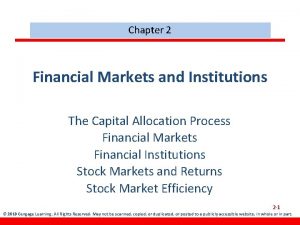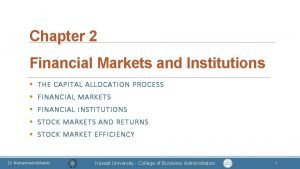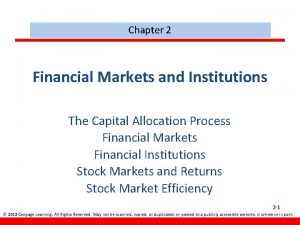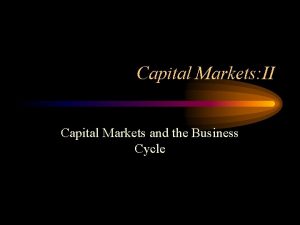Financial Markets Institutions Chapter 2 Capital Allocation Financial












- Slides: 12

Financial Markets & Institutions Chapter 2 Capital. Allocation Financial Markets Market Efficiency All Rights Reserved Chapter 5 Slide 1

FINANCIAL INTERMEDIARIES • JOB #1: ALLOCATING CAPITAL – Direct investment – Investment Bankers • Advise • Underwrite • Distribute – Indirect Financial Intermediaries • Stock Brokerages (act as agents/principals) • Mutual Funds (invest savings) • Banks (lending capital) All Rights Reserved Chapter 5 Slide 2

Financial Institutions A. Investment Intermediaries 1. Investment Bankers 2. Mutual Fund Companies, Finance Companies B. Depository Institutions 1. Banks, Credit Unions, Savings & Loan Associations C. Contractual Savings Institutions 1. Insurance Companies, Pension Funds All Rights Reserved Chapter 5 Slide 3

FINANCIAL MARKETS A. Types of Markets 1. Primary; where new issues are sold – IPO (Initial Public Offering) – Additional issues of new stock 2. Secondary; where seasoned issues are bought and sold. 3. Money markets; where short-term debt instruments are bought and sold. All Rights Reserved Chapter 5 Slide 4

FINANCIAL MARKETS 4. Capital markets; where long-term debt instruments are bought and sold. Fig 5 -1 5. Futures market; where derived claims are bought and sold on physical goods. 6. Options market; where derived claims are bought and sold on financial claims – Futures and options are termed derivative securities in that they derive their value from the value of the underlying asset. All Rights Reserved Chapter 5 Slide 5

FINANCIAL MARKETS B. Market Makers (Specialists and Dealers); 1. New York Stock Exchange (NYSE) Specialist System; (AMEX also) (auction market) 2. Over-The-Counter Market Maker/Dealer System (NASDAQ system); (dealer market) 3. Bid-Ask spread; cost of liquidity services. All Rights Reserved Chapter 5 Slide 6

FINANCIAL MARKETS C. Security exchanges 1. 2. 3. 4. Owned by its members, regulated by the SEC. Trade as principals or as agents. Floor dominated by stock transactions. Bonds mostly traded in the OTC market. All Rights Reserved Chapter 5 Slide 7

FINANCIAL MARKETS D. Reporting of transactions; 1. Reported on the ticker tape; Ticker Symbol, price, volume. 2. Summary of trading activity in the WSJ, Barron’s, other periodicals. 3. The "Market" = highest offer to buy (bid), lowest offer to sell (ask). All Rights Reserved Chapter 5 Slide 8

FINANCIAL MARKETS E. Foreign Securities; must be registered to trade in US markets. 1. ADR's; shares of foreign companies trading like those of American companies. 2. US. subsidiaries of foreign corporations which have stock outstanding. All Rights Reserved Chapter 5 Slide 9

STOCK MARKET REPORTING A. Indexes 1. Dow Jones Industrial Average (DJIA); 30 2. S&P 500 (composite index) ; 400 (industrials 3. NASDAQ Series; Composite, Industrials B. Media Sources 1. Nightly Business Report; daily wrap-up. 2. Wall Street Week; analysis, strategies, etc. 3. Barrons, Forbes, Financial Section of the NY Times, Investors daily, letters. All Rights Reserved Chapter 5 Slide 10

MARKET EFFICIENCY A. Efficient Markets Hypothesis 1. Prices reflect all known information. 2. Three Levels of Market Efficiency; a. Weak form (old info) b. Semi-Strong form (new info) c. Strong form efficiency (inside info) 3. Implication of EMH; you cannot consistently outperform the market. B. Investigate before you invest – and remember – there are NO SURE THINGS – ONLY FOOLS All Rights Reserved Chapter 5 Slide 11

HOMEWORK CHAPTER 2 A. Self-Test: ST-1, parts a, b, c, f B. Questions: 2 -2, 2 -4, 2 -5, 2 -10 All Rights Reserved Chapter 5 Slide 12
 Financial markets and the allocation of capital
Financial markets and the allocation of capital Why study financial markets and institutions?
Why study financial markets and institutions? Participants of money market
Participants of money market Financial markets and institutions ppt
Financial markets and institutions ppt Financial markets instruments and institutions
Financial markets instruments and institutions Madura j. financial markets and institutions
Madura j. financial markets and institutions Role of financial markets and institutions
Role of financial markets and institutions Madura j financial markets and institutions
Madura j financial markets and institutions Why study financial markets and institutions
Why study financial markets and institutions Capital allocation line vs capital market line
Capital allocation line vs capital market line Capital markets and financial intermediation
Capital markets and financial intermediation Contiguous allocation vs linked allocation
Contiguous allocation vs linked allocation Chapter 12 money and financial institutions
Chapter 12 money and financial institutions




